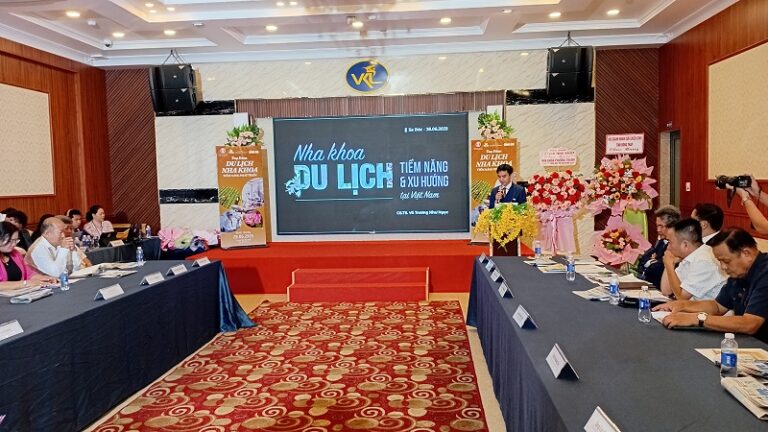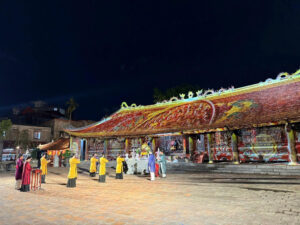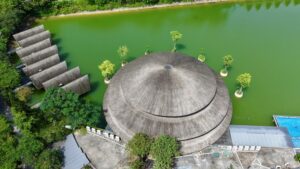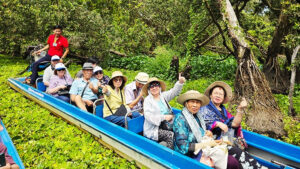One of the Vietnam’s largest national parks, Cat Tien, is a wildlife enthusiast’s dream.
Cat Tien National Park, one of Vietnam’s eight UNESCO world biosphere reserves, is home to 18 of 19 bird orders found anywhere in the country.
The 71,350-hectare park in the southern provinces of Dong Nai and Binh Phuoc and the Central Highlands province of Lam Dong also has around 1,600 animal and plant species each.
Many are red-listed, meaning endangered, like the black-shanked douc (Pygathrix nigripes), mountain or helmeted toad (Sindora siamensis), branched oyster mushrooms (Pleurotus Cornucopiae), and go do (Afzelia xylocarpa).
The park is thus a paradise for nature lovers, and easily accessible, thanks to lots of infrastructure works recently and the guidance of forest rangers.
There are various areas named after their representative species - like the Mo Vet (Parrot peak) waterfall, Bau Ca (Fish lake), and Bau Nai (Deer lake), and each one is worth discovering.
One spot not to be missed is Bau Sau (Crocodile lake), which is in the Ramsar list of wetlands of international importance.
The area, which has 13,759 hectares under water, is some 14 kilometers from the visitors’ rooms and almost accessible by car or bicycle.
But tourists, thankfully for them, have to walk the last five kilometers. It is a spectacular experience walking through the primeval forest with giant trees that are hundreds of years old, spotting monkeys and birds along the path. Occasionally reptiles like snakes and salamanders can also be seen.
Visitors have to cross a wooden bridge to enter Bau Sau, which has a unique ecosystem with its submerged trees and a large lake. They can choose one of the huts there for catching their breath or observing the wildlife.
By day the place is like a theater with peacocks dancing to the music of birds. At night animals come to the water to drink while crocodiles emerge to look for food.
Since the park has large numbers of different species, visitors often go in specialized groups. Some come to study butterflies, some choose insects, while others look for primates or birds.
My personal favorite is the night safari between 7 p.m. and 9 p.m. every day. Starting at the main tourist area, a car takes groups of five to seven people through the forest. Visitors can spot deer, wild boars, hedgehogs, and civet cats moving in the dark.
The 50-minute tour can by booked by contacting the reception in advance.
The Endangered Primates Species Center on Tien (Fairy) Island, which is five minutes by boat from the rooms, opened in 2008 and works to rescue and rehabilitate primates seized from poachers in neighboring areas.
Visitors can see black shanked doucs, silver langurs, and pygmy loris being readied for re-release in the wild and learn about their stories.
This trip, costing VND150,000 (US$8), has to be booked at the Cat Tien Tourism Office.
Another center operating inside the park is the Cat Tien Bear and Wild Cat Rescue Station, which treats other animals like Sun bears, Asian black bears, leopards, and crocodiles.
More than a sanctuary
Cat Tien is home to not only exotic flora and fauna but also two ethnic minority peoples - the Ma and the Stieng.
They carefully preserve their traditions as can be seen in their daily activities, festivals, and musical instruments.
Since their villages in Ta Lai Commune, some 12 kilometers from the rooms, are open to tourists, one can go there, take a tour, and join the locals in their daily activities.
Ma women are famous for brocade weaving skills and visitors should not fail to buy their brocades.
Another interesting destination is the Cat Tien archeological site, some 20 kilometers away.
The site, discovered in 1985, stretches more than 10 kilometers along the right bank of the Dong Nai River, and has seven temple towers located on seven hills. Various artifacts have been excavated there, like stone linga and yoni that are 2.1 meters tall.
Scientists suspect it was a holy site dating back to the 3rd-5th centuries, and have unearthed Hindu remnants like tombs and boxes containing the ashes of people who are thought to have practiced Brahmanism.














